Answered step by step
Verified Expert Solution
Question
1 Approved Answer
Using the data assembled by Mr. McCarthy, compute revised cost figures for two patients. the yuce in the ab, whereas the complex tests TOOK UD
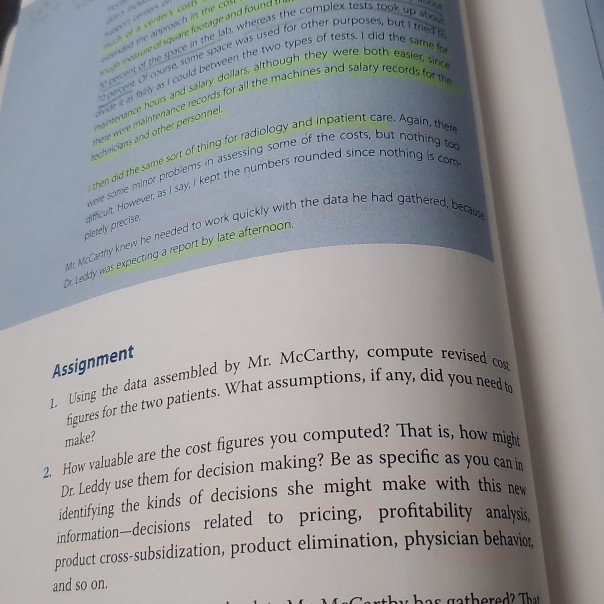
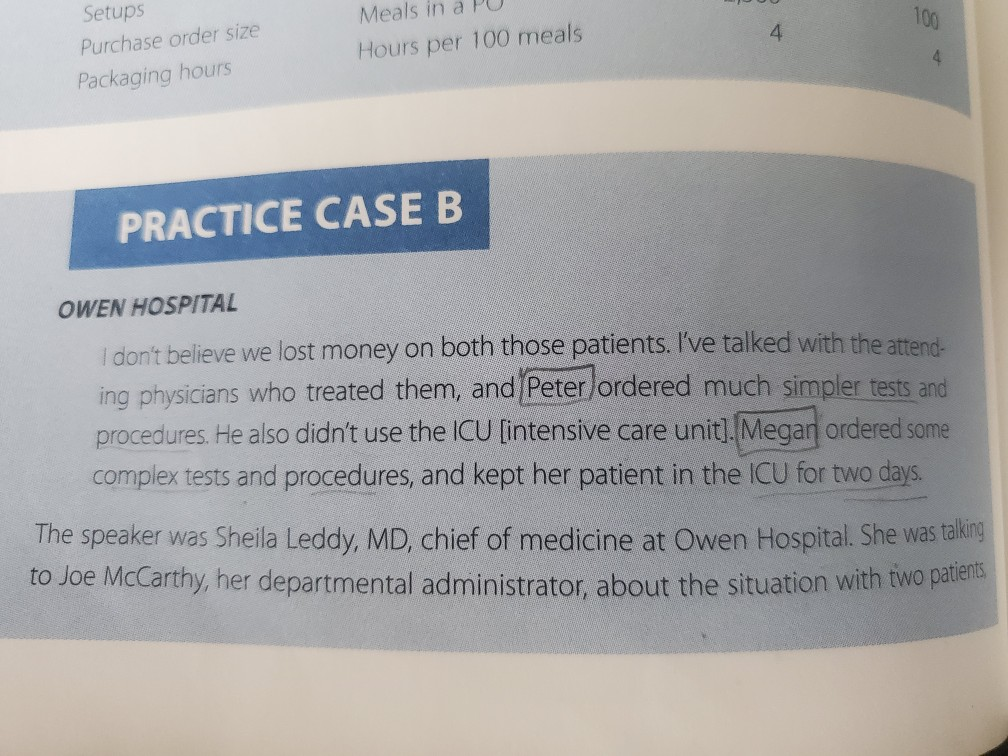
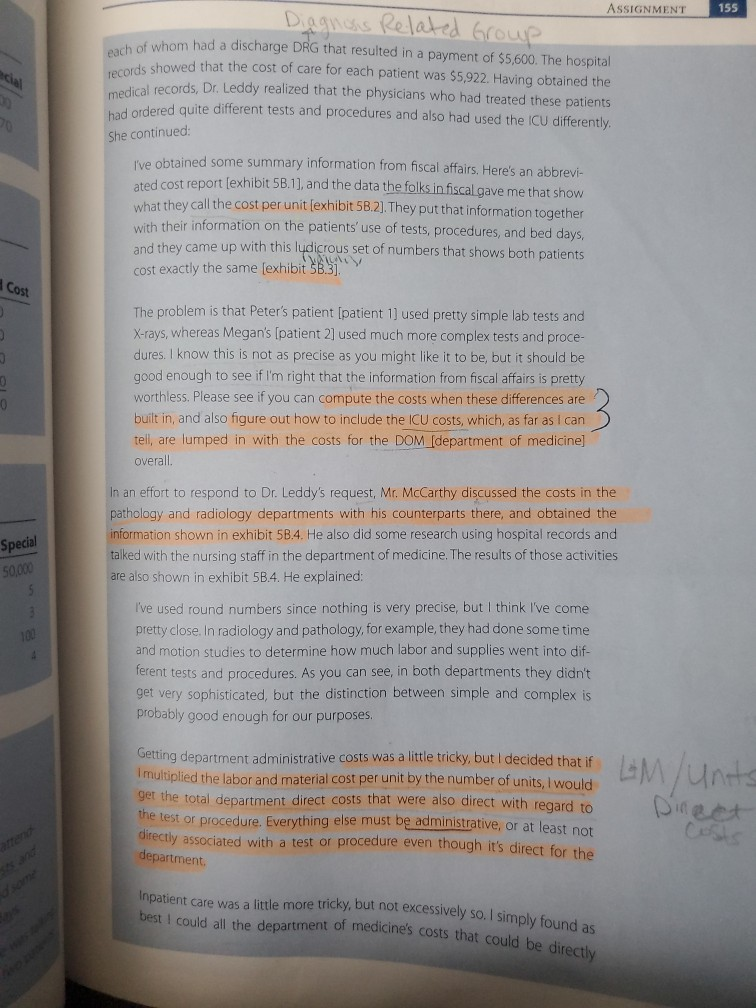
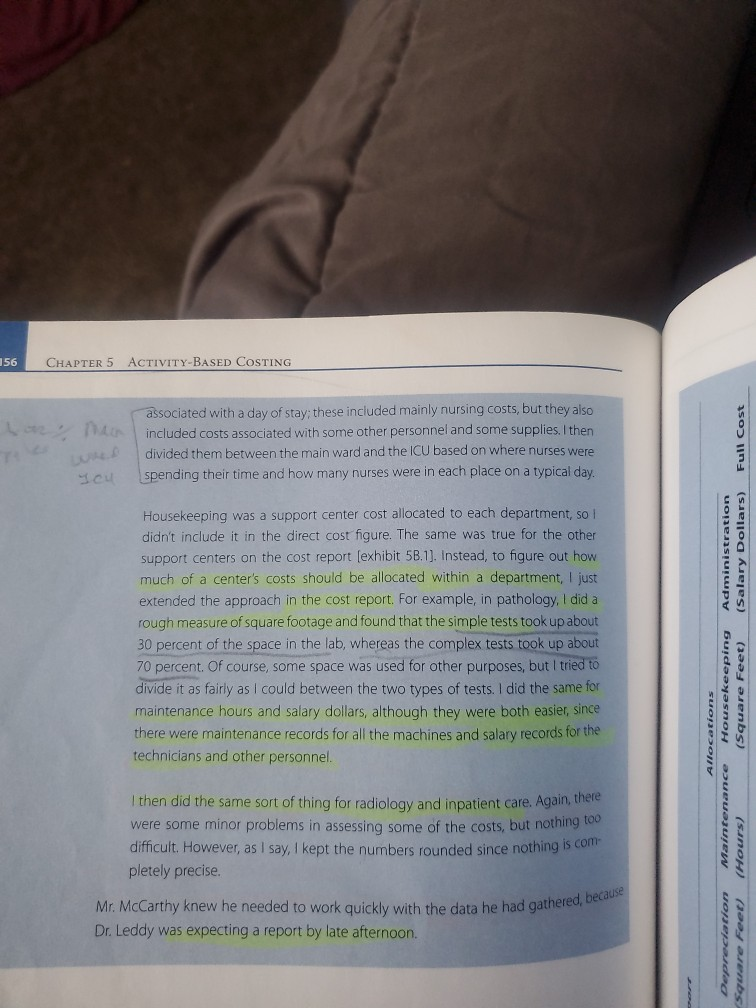
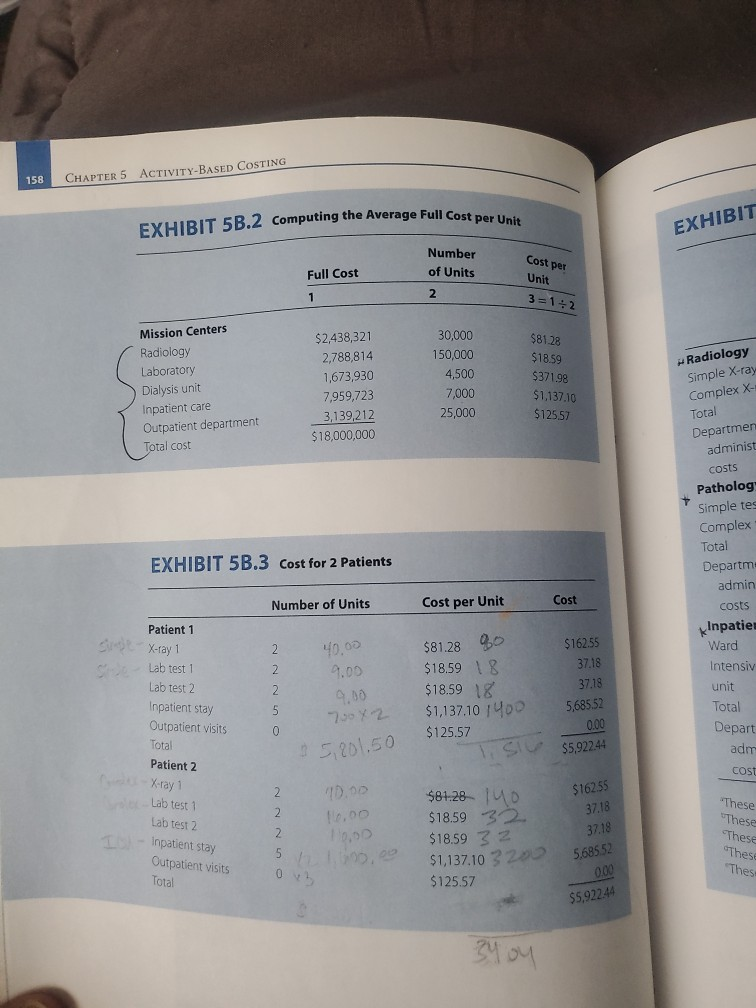
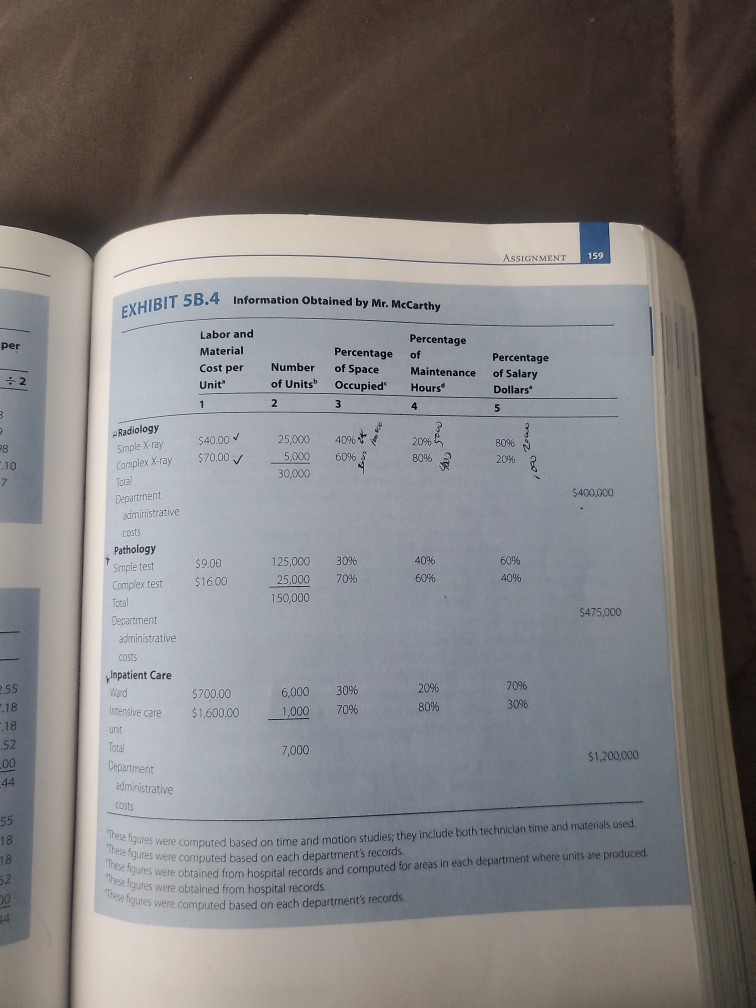
Using the data assembled by Mr. McCarthy, compute revised cost figures for two patients.
the yuce in the ab, whereas the complex tests TOOK UD se some salce was used for other purposes, but it to as cold between the two types of tests. I did the sorte e hours and salary dollars, although they were both easier. Sy then did the same sort of thing for radiology and Inpatient care. Again, there ve some minor problems in assessing some of the costs, but nothing too A Month knew he needed to work quickly with the data he had gathered, becaus DLAR was expecting a report by late afternoon. there were maintenance records for all the machines and salary records for the ut Homeseas/ say, I kept the numbers rounded since nothing is com 1. Using the data assembled by Mr. McCarthy, compute revised figures for the two patients. What assumptions, if any, did you need to 2. How valuable are the cost figures you computed? That is, how might Dr Leddy use them for decision making? Be as specific as you can in identifying the kinds of decisions she might make with this new och in the col square footage and found chcons and other personnel plere precise Assignment make? informationdecisions related to pricing, profitability analysis product cross-subsidization, product elimination, physician behavior, and so on Contburbas matbered? That Setups 100 Meals in Hours per 100 meals 4 4 Purchase order size Packaging hours PRACTICE CASE B OWEN HOSPITAL I don't believe we lost money on both those patients. I've talked with the attend ing physicians who treated them, and Peter Jordered much simpler tests and procedures. He also didn't use the ICU [intensive care unit). Megan ordered some complex tests and procedures, and kept her patient in the ICU for two days. The speaker was Sheila Leddy, MD, chief of medicine at Owen Hospital. She was talking to Joe McCarthy, her departmental administrator, about the situation with two patients records showed that the cost of care for each patient was $5,922. Having obtained the best I could all the department of medicine's costs that could be directly 155 ASSIGNMENT Diagnosis Related Group each of whom had a discharge DRG that resulted in a payment of $5,600. The hospital medical records, Dr. Leddy realized that the physicians who had treated these patients had ordered quite different tests and procedures and also had used the ICU differently. She continued: I've obtained some summary information from fiscal affairs. Here's an abbrevi- ated cost report (exhibit 58.1), and the data the folks in fiscal gave me that show what they call the cost per unit (exhibit 5B.2]. They put that information together with their information on the patients' use of tests, procedures, and bed days, and they came up with this ludicrous set of numbers that shows both patients cost exactly the same exhibit 5B.3]. Cost The problem is that Peter's patient (patient 1) used pretty simple lab tests and X-rays, whereas Megan's (patient 2] used much more complex tests and proce- dures. I know this is not as precise as you might like it to be, but it should be good enough to see if I'm right that the information from fiscal affairs is pretty worthless. Please see if you can compute the costs when these differences are built in, and also figure out how to include the ICU costs, which, as far as I can tell, are lumped in with the costs for the DOM [department of medicine] overall 0 In an effort to respond to Dr. Leddy's request, Mr. McCarthy discussed the costs in the pathology and radiology departments with his counterparts there, and obtained the information shown in exhibit 58.4. He also did some research using hospital records and talked with the nursing staff in the department of medicine. The results of those activities are also shown in exhibit 5B.4. He explained: Special 50.000 5 100 . I've used round numbers since nothing is very precise, but I think I've come pretty close. In radiology and pathology, for example, they had done some time and motion studies to determine how much labor and supplies went into dif- ferent tests and procedures. As you can see, in both departments they didn't get very sophisticated, but the distinction between simple and complex is probably good enough for our purposes. Getting department administrative costs was a little tricky, but I decided that if I multiplied the labor and material cost per unit by the number of units, I would get the total department direct costs that were also direct with regard to the test or procedure. Everything else must be administrative, or at least not directly associated with a test or procedure even though it's direct for the LM / units Direct costs department Inpatient care was a little more tricky, but not excessively so. I simply found as Full Cost Mr. McCarthy knew he needed to work quickly with the data he had gathered, because 156 CHAPTER 5 ACTIVITY-BASED COSTING associated with a day of stay, these included mainly nursing costs, but they also included costs associated with some other personnel and some supplies. I then divided them between the main ward and the ICU based on where nurses were spending their time and how many nurses were in each place on a typical day. Housekeeping was a support center cost allocated to each department, so didn't include it in the direct cost figure. The same was true for the other support centers on the cost report exhibit 5B.1). Instead, to figure out how much of a center's costs should be allocated within a department, I just extended the approach in the cost report. For example, in pathology, I did a rough measure of square footage and found that the simple tests took up about 30 percent of the space in the lab, whereas the complex tests took up about 70 percent. Of course, some space was used for other purposes, but I tried to divide it as fairly as I could between the two types of tests. I did the same for maintenance hours and salary dollars, although they were both easier, since there were maintenance records for all the machines and salary records for the technicians and other personnel. I then did the same sort of thing for radiology and inpatient care. Again, there were some minor problems in assessing some of the costs, but nothing to difficult. However, as I say, I kept the numbers rounded since nothing is com pletely precise. Dr. Leddy was expecting a report by late afternoon. Administration (Salary Dollars) Housekeeping Allocations (Square Feet) Maintenance Hours) Depreciation Square Feet) EXHIBIT 5B.2 Computing the Average Full Cost per Unit 158 CHAPTER 5 ACTIVITY-BASED COSTING EXHIBIT Full Cost Number of Units 2 Cost per Unit 3= 1+2 1 Mission Centers Radiology Laboratory Dialysis unit Inpatient care Outpatient department Total cost $2,438,321 2,788,814 1,673,930 7,959,723 3,139,212 $18,000,000 30,000 150,000 4.500 7,000 25,000 $81.28 $18.99 $37198 $1,137.10 $12557 Radiology Simple X-ray Complex X- Total Departmen administ costs T EXHIBIT 5B.3 Cost for 2 Patients Number of Units Cost per Unit Cost Patholog Simple tes Complex Total Departm admin costs kinpatie Ward Intensiv unit Total Depart adm Patient 1 X-ray 1 Labtest 1 2. 2 2 5 40.00 9.00 9.00 70042 5,201.50 $81.28 00 $162.55 $18.59 18 37.18 $18.59 18 37.18 $1,137.10 1400 5,685,52 $125.57 0.00 | 359224 0 COST Labtest 2 Inpatient stay Outpatient visits Total Patient 2 -X-ray 1 Labtest 1 Labtest 2 Linpatient stay Outpatient visits Total 2 2 2 5 10.00 10.00 "These "These $84.28140 $18.5932 $18.59 3 2 $1,137.10 329 $125.57 10,00 500.00 These $16255 37.18 37.18 5,68552 0.00 $5,922.44 These Thest 3404 EXHIBIT 5B.4 Information Obtained by Mr. McCarthy These figures were computed based on each department's records These figures were computed based on time and motion studies, they include both technician time and materials used These foutes were obtained from hospital records and computed for areas in each department where units are produced he figures were obtained from hospital records These figures were computed based on each department's records. ASSIGNMENT 159 per Labor and Material Cost per Unit 1 Number of Units 2 2 Percentage of Maintenance Hours Percentage of Space Occupied 3 Percentage of Salary Dollars 5 4 m $40.00 25,000 40% 28 $70.00 5.000 60% 80% 20% -10 7 30,000 $400,000 Radiology Simple X-ray Complex X-ray Cora Department administrative costs Pathology Simple test Complex test Total $9.00 $16.00 125,000 25,000 150,000 30% 70% 40% 60% 60% 40% $475,000 Department administrative costs Inpatient Care Ward $700.00 $1,600.00 6,000 1,000 30% 70% 20% 80% 7096 30% Intensive care 255 7.18 18 52 200 7,000 $ 1.200.000 unt Total Department administrative costs 55 18 18 52 the yuce in the ab, whereas the complex tests TOOK UD se some salce was used for other purposes, but it to as cold between the two types of tests. I did the sorte e hours and salary dollars, although they were both easier. Sy then did the same sort of thing for radiology and Inpatient care. Again, there ve some minor problems in assessing some of the costs, but nothing too A Month knew he needed to work quickly with the data he had gathered, becaus DLAR was expecting a report by late afternoon. there were maintenance records for all the machines and salary records for the ut Homeseas/ say, I kept the numbers rounded since nothing is com 1. Using the data assembled by Mr. McCarthy, compute revised figures for the two patients. What assumptions, if any, did you need to 2. How valuable are the cost figures you computed? That is, how might Dr Leddy use them for decision making? Be as specific as you can in identifying the kinds of decisions she might make with this new och in the col square footage and found chcons and other personnel plere precise Assignment make? informationdecisions related to pricing, profitability analysis product cross-subsidization, product elimination, physician behavior, and so on Contburbas matbered? That Setups 100 Meals in Hours per 100 meals 4 4 Purchase order size Packaging hours PRACTICE CASE B OWEN HOSPITAL I don't believe we lost money on both those patients. I've talked with the attend ing physicians who treated them, and Peter Jordered much simpler tests and procedures. He also didn't use the ICU [intensive care unit). Megan ordered some complex tests and procedures, and kept her patient in the ICU for two days. The speaker was Sheila Leddy, MD, chief of medicine at Owen Hospital. She was talking to Joe McCarthy, her departmental administrator, about the situation with two patients records showed that the cost of care for each patient was $5,922. Having obtained the best I could all the department of medicine's costs that could be directly 155 ASSIGNMENT Diagnosis Related Group each of whom had a discharge DRG that resulted in a payment of $5,600. The hospital medical records, Dr. Leddy realized that the physicians who had treated these patients had ordered quite different tests and procedures and also had used the ICU differently. She continued: I've obtained some summary information from fiscal affairs. Here's an abbrevi- ated cost report (exhibit 58.1), and the data the folks in fiscal gave me that show what they call the cost per unit (exhibit 5B.2]. They put that information together with their information on the patients' use of tests, procedures, and bed days, and they came up with this ludicrous set of numbers that shows both patients cost exactly the same exhibit 5B.3]. Cost The problem is that Peter's patient (patient 1) used pretty simple lab tests and X-rays, whereas Megan's (patient 2] used much more complex tests and proce- dures. I know this is not as precise as you might like it to be, but it should be good enough to see if I'm right that the information from fiscal affairs is pretty worthless. Please see if you can compute the costs when these differences are built in, and also figure out how to include the ICU costs, which, as far as I can tell, are lumped in with the costs for the DOM [department of medicine] overall 0 In an effort to respond to Dr. Leddy's request, Mr. McCarthy discussed the costs in the pathology and radiology departments with his counterparts there, and obtained the information shown in exhibit 58.4. He also did some research using hospital records and talked with the nursing staff in the department of medicine. The results of those activities are also shown in exhibit 5B.4. He explained: Special 50.000 5 100 . I've used round numbers since nothing is very precise, but I think I've come pretty close. In radiology and pathology, for example, they had done some time and motion studies to determine how much labor and supplies went into dif- ferent tests and procedures. As you can see, in both departments they didn't get very sophisticated, but the distinction between simple and complex is probably good enough for our purposes. Getting department administrative costs was a little tricky, but I decided that if I multiplied the labor and material cost per unit by the number of units, I would get the total department direct costs that were also direct with regard to the test or procedure. Everything else must be administrative, or at least not directly associated with a test or procedure even though it's direct for the LM / units Direct costs department Inpatient care was a little more tricky, but not excessively so. I simply found as Full Cost Mr. McCarthy knew he needed to work quickly with the data he had gathered, because 156 CHAPTER 5 ACTIVITY-BASED COSTING associated with a day of stay, these included mainly nursing costs, but they also included costs associated with some other personnel and some supplies. I then divided them between the main ward and the ICU based on where nurses were spending their time and how many nurses were in each place on a typical day. Housekeeping was a support center cost allocated to each department, so didn't include it in the direct cost figure. The same was true for the other support centers on the cost report exhibit 5B.1). Instead, to figure out how much of a center's costs should be allocated within a department, I just extended the approach in the cost report. For example, in pathology, I did a rough measure of square footage and found that the simple tests took up about 30 percent of the space in the lab, whereas the complex tests took up about 70 percent. Of course, some space was used for other purposes, but I tried to divide it as fairly as I could between the two types of tests. I did the same for maintenance hours and salary dollars, although they were both easier, since there were maintenance records for all the machines and salary records for the technicians and other personnel. I then did the same sort of thing for radiology and inpatient care. Again, there were some minor problems in assessing some of the costs, but nothing to difficult. However, as I say, I kept the numbers rounded since nothing is com pletely precise. Dr. Leddy was expecting a report by late afternoon. Administration (Salary Dollars) Housekeeping Allocations (Square Feet) Maintenance Hours) Depreciation Square Feet) EXHIBIT 5B.2 Computing the Average Full Cost per Unit 158 CHAPTER 5 ACTIVITY-BASED COSTING EXHIBIT Full Cost Number of Units 2 Cost per Unit 3= 1+2 1 Mission Centers Radiology Laboratory Dialysis unit Inpatient care Outpatient department Total cost $2,438,321 2,788,814 1,673,930 7,959,723 3,139,212 $18,000,000 30,000 150,000 4.500 7,000 25,000 $81.28 $18.99 $37198 $1,137.10 $12557 Radiology Simple X-ray Complex X- Total Departmen administ costs T EXHIBIT 5B.3 Cost for 2 Patients Number of Units Cost per Unit Cost Patholog Simple tes Complex Total Departm admin costs kinpatie Ward Intensiv unit Total Depart adm Patient 1 X-ray 1 Labtest 1 2. 2 2 5 40.00 9.00 9.00 70042 5,201.50 $81.28 00 $162.55 $18.59 18 37.18 $18.59 18 37.18 $1,137.10 1400 5,685,52 $125.57 0.00 | 359224 0 COST Labtest 2 Inpatient stay Outpatient visits Total Patient 2 -X-ray 1 Labtest 1 Labtest 2 Linpatient stay Outpatient visits Total 2 2 2 5 10.00 10.00 "These "These $84.28140 $18.5932 $18.59 3 2 $1,137.10 329 $125.57 10,00 500.00 These $16255 37.18 37.18 5,68552 0.00 $5,922.44 These Thest 3404 EXHIBIT 5B.4 Information Obtained by Mr. McCarthy These figures were computed based on each department's records These figures were computed based on time and motion studies, they include both technician time and materials used These foutes were obtained from hospital records and computed for areas in each department where units are produced he figures were obtained from hospital records These figures were computed based on each department's records. ASSIGNMENT 159 per Labor and Material Cost per Unit 1 Number of Units 2 2 Percentage of Maintenance Hours Percentage of Space Occupied 3 Percentage of Salary Dollars 5 4 m $40.00 25,000 40% 28 $70.00 5.000 60% 80% 20% -10 7 30,000 $400,000 Radiology Simple X-ray Complex X-ray Cora Department administrative costs Pathology Simple test Complex test Total $9.00 $16.00 125,000 25,000 150,000 30% 70% 40% 60% 60% 40% $475,000 Department administrative costs Inpatient Care Ward $700.00 $1,600.00 6,000 1,000 30% 70% 20% 80% 7096 30% Intensive care 255 7.18 18 52 200 7,000 $ 1.200.000 unt Total Department administrative costs 55 18 18 52Step by Step Solution
There are 3 Steps involved in it
Step: 1

Get Instant Access to Expert-Tailored Solutions
See step-by-step solutions with expert insights and AI powered tools for academic success
Step: 2

Step: 3

Ace Your Homework with AI
Get the answers you need in no time with our AI-driven, step-by-step assistance
Get Started


